As you stand at the ghats of Varanasi, the sacred city's spiritual energy envelops you, but have you ever wondered what lies beyond its ancient streets? Just a stone's throw away, within a 100 km radius, lies a treasure trove of hidden gems waiting to be discovered. Imagine uncovering the secrets of the Vindhyachal Temple Complex, where intricate carvings and ornate architecture transport you to a bygone era. But that's just the beginning – there's so much more to explore, and we're about to uncover the best-kept secrets near Varanasi.
Key Takeaways
- Vindhyachal Temple Complex, a treasure trove of cultural heritage, offers breathtaking views of the Ganges River and Karmanasa rivers' confluence.
- Lakhaniya Hills Waterfall, a natural wonder, is surrounded by lush green forests, creating a tranquil atmosphere.
- Rajdari Devi Waterfall, a hidden gem, promises an unforgettable experience amidst nature's splendor, situated within a 100 km radius of Varanasi.
- Chunar Fort, a protected monument, invites exploration of India's rich cultural heritage, blending Indian, Persian, and Islamic architectural styles.
- Sitamarhi's ancient Sita Temple, a sacred site, beckons devotees and curious travelers, housing idols of Lord Rama, Lakshmana, and Hanuman.
Vindhyachal Temple Complex
As you plan your visit to the Vindhyachal Temple Complex, get ready to immerse yourself in a world of spirituality and history.
You'll be amazed by the intricate carvings that adorn the ancient temple walls, and you'll want to wear comfortable shoes to explore the complex with ease.
From its stunning architecture to its serene atmosphere, this revered Shakti Peeth has plenty of surprises in store for you.
Overview
Perched atop a hill, the Vindhyachal Temple Complex majestically overlooks the confluence of the Karmanasa and Ganges rivers, its intricate carvings and ornate architecture a reflection of the region's rich cultural heritage.
As you approach the complex, you'll be struck by the serenity of the surroundings, which seem to whisper tales of Varanasi's history.
The temple's strategic location offers a breathtaking view of the rivers, making it a popular spot for devotees and tourists alike.
You'll notice the temple's cultural significance as you explore the complex.
The intricate carvings and ornate architecture are examples of the region's rich cultural heritage, which dates back to the ancient times of Varanasi.
The temple's historical significance is undeniable, and as you wander through the complex, you'll uncover the many layers of Varanasi's history.
From the mythological stories to the architectural marvels, every aspect of the Vindhyachal Temple Complex is a demonstration of the region's cultural significance.
Ancient Temple Carvings
Your eyes will be drawn to the stunning ancient temple carvings that adorn the walls of the Vindhyachal Temple Complex, masterpieces that showcase exceptional craftsmanship and artistic excellence.
As you explore the temple complex, you'll notice the intricate designs and patterns that cover every inch of the walls, showcasing the skillful hands of the artisans who created them. The carvings depict scenes from the Puranas, Mahabharata, and Ramayana, making it a treasure trove for art lovers and historians.
The temple's architecture is a blend of Nagara and Dravidian styles, with the main shrine housing a beautiful idol of Goddess Vindhyavasini.
The temple walls are adorned with intricate carvings and sculptures, a demonstration of the advanced carving techniques used by the artisans. Despite being centuries old, the carvings still retain their beauty, thanks to the ongoing temple restoration efforts.
As you marvel at the ancient temple carvings, you'll appreciate the dedication and craftsmanship that went into creating these masterpieces.
Wear Comfortable Walking Shoes
Before you set out on a journey to explore the Vindhyachal Temple Complex, make sure to lace up comfortable walking shoes, as you'll need them to navigate the sprawling complex's numerous stairs and uneven terrain.
You'll be grateful for the Sole Protection and Heel Support as you climb up and down the stairs, exploring the multiple temples, including the Vindhyavasini Devi Temple, Ashtabhuja Temple, and Kali Khoh Temple.
The complex's uneven paths and steep stairs can be challenging, especially during the monsoon season when the paths can be slippery.
Wearing shoes with good grip and traction will give you the confidence to explore the complex without worrying about slipping or falling.
Comfortable walking shoes will also allow you to take in the breathtaking scenic beauty of the Vindhyachal hills and the Ganges River.
Opt for lightweight, breathable, and moisture-wicking shoes to keep your feet cool and dry during the hot summer months.
With the right shoes, you'll be ready to take on the Vindhyachal Temple Complex and all its wonders.
Lakhaniya Hills Waterfall
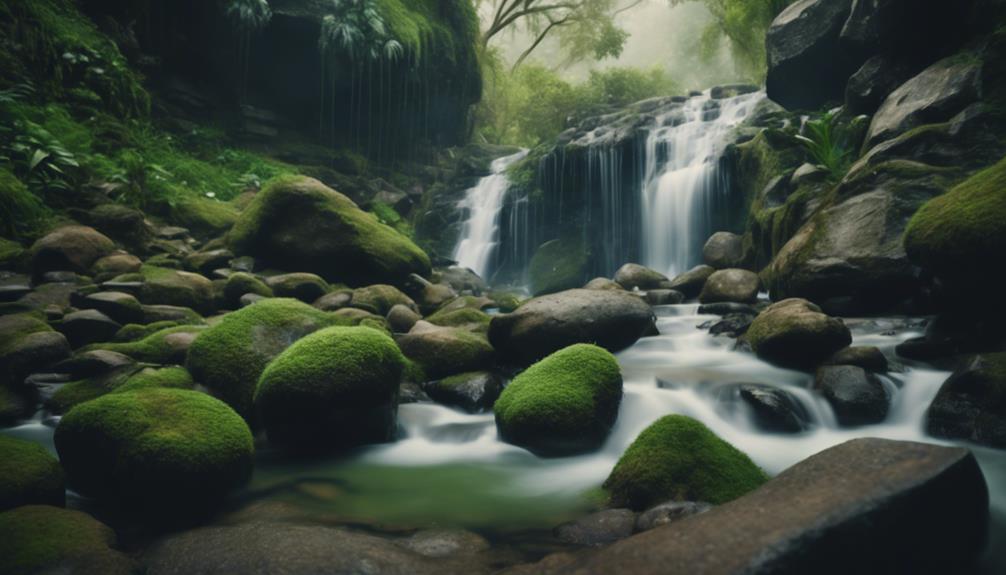
As you explore the outskirts of Varanasi, you'll stumble upon the breathtaking Lakhaniya Hills Waterfall, a hidden gem waiting to be discovered.
You'll be mesmerized by the serene atmosphere and lush green forests surrounding this 150-meter-high waterfall.
Get ready to soak in the natural beauty of this stunning spot, and let's start with an overview of what makes it a must-visit destination.
Overview
Tucked away in the heart of the Indian state of Uttar Pradesh, the Lakhaniya Hills Waterfall is a breathtaking natural wonder that awaits your discovery.
As you venture into this hidden gem, you'll be surrounded by lush green forests and the gentle hum of nature. The waterfall's tranquil atmosphere is the perfect antidote to the hustle and bustle of city life, making it an ideal day-trip from Varanasi.
As you explore the area, you'll uncover the rich cultural significance of this region.
The waterfall is nestled in an area steeped in Varanasi history, where myth and legend blend seamlessly with reality. You'll sense the spiritual energy that permeates this land, where ancient traditions and customs continue to thrive.
The Lakhaniya Hills Waterfall is more than just a natural wonder – it's a window into the region's fascinating cultural heritage. As you soak in the beauty of this waterfall, you'll come away with a deeper appreciation for the cultural significance of this enchanting region.
Stunning Lakhaniya Hills View
Standing atop the Lakhaniya Hills, you're immediately struck by the breathtaking panorama unfolding before your eyes, as the waterfall cascades down the rocky slope, creating a misty veil that dances in the sunlight.
The roar of the waterfall grows louder as you descend into the valley, where the lush green surroundings and the gentle rustle of leaves create a soothing ambiance.
As you explore the hilltop villages, you'll discover the rustic charm of rural India, with villagers going about their daily lives, oblivious to the natural beauty that surrounds them.
The scenic routes that wind their way up to the hills offer stunning views of the surrounding landscape, with the distant sound of the waterfall creating a sense of anticipation.
Take a moment to soak in the tranquility of the surroundings, and let the beauty of Lakhaniya Hills leave you enchanted.
With its unique blend of natural beauty and rustic charm, Lakhaniya Hills is a must-visit destination for anyone looking to escape the chaos of city life.
Carry Refillable Water Bottles
Before you set out on your Lakhaniya Hills adventure, remember to pack a refillable water bottle to stay hydrated and reduce your environmental footprint.
As you hike through the lush green trails, the last thing you want is to contribute to the already massive plastic waste problem.
By carrying a refillable water bottle, you're not only ensuring you stay hydrated but also practicing eco-friendly habits.
As you explore the stunning Lakhaniya Hills Waterfall, remember that sustainable tourism is all about respecting the environment and local communities.
By making conscious choices, like carrying refillable water bottles, you're contributing to a greener and more responsible form of tourism.
Imagine the collective impact if every traveler made this simple switch!
Rajdari Devi Waterfall
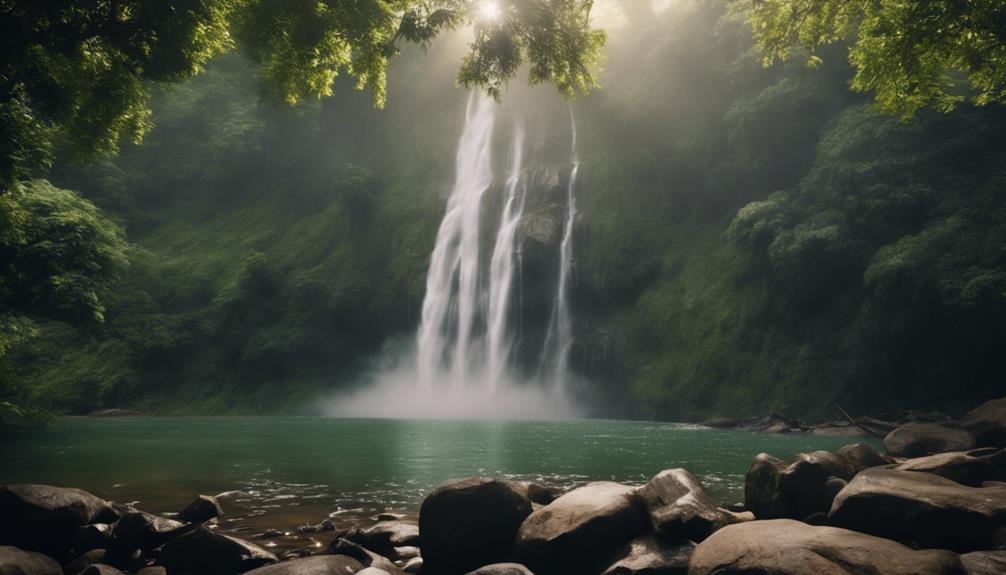
As you venture to Rajdari Devi Waterfall, you'll be greeted by the serene surroundings of the picturesque waterfall.
Get ready to be mesmerized by the sparkling cascade view, where crystal-clear water flows gently down the rocky terrain.
Before you head out, remember to pack sunscreen and hats to protect yourself from the sun, ensuring a comfortable and enjoyable experience.
Overview
Located just within a 100 km radius of Varanasi, Rajdari Devi Waterfall in Chandauli district is a hidden gem waiting to be explored, promising an unforgettable experience amidst nature's splendor.
As you approach the waterfall, you'll be struck by the serene atmosphere that pervades the area. The lush green surroundings and the gentle rustling of leaves in the breeze create a sense of tranquility, making it an ideal spot to relax and unwind.
You'll have the opportunity to soak in the local legends and village culture that permeate the area. Take a stroll through the dense forest surrounding the waterfall, and you might stumble upon hidden clearings, rustic villages, or ancient temples.
The villagers, warm and welcoming, will regale you with stories of the region's rich history and mythology. As you explore the area, you'll discover the unique blend of traditional village culture and natural beauty that makes Rajdari Devi Waterfall a must-visit destination near Varanasi.
Sparkling Waterfall Cascade View
Standing at the edge of the Rajdari Devi Waterfall, you're immediately struck by the breathtaking cascade view, where crystal-clear waters tumble 100 feet down a rocky cliff, creating a mesmerizing display of nature's power and beauty.
As you take in the sight, you can't help but feel the urge to explore further.
The Rajdari Devi Waterfall is a haven for nature lovers and adventure seekers alike.
You can set out on a thrilling Waterfall Hiking adventure, trekking through lush green forests and scenic trails that lead you to the waterfall's base.
The scenery is a Nature Photography enthusiast's dream come true, with the misty veil surrounding the waterfall, the lush greenery, and the rustic landscape.
Take a moment to breathe in the fresh air, listen to the soothing sounds of the waterfall, and let the serenity of the surroundings wash over you.
Whether you're looking for an adrenaline rush or a peaceful retreat, the Rajdari Devi Waterfall has something to offer.
Pack Sunscreen and Hats
Before you set out on your thrilling adventure to Rajdari Devi Waterfall, make sure to pack sunscreen with a high SPF and a hat to shield yourself from the scorching sun that beats down on the trails and viewing areas.
The sunscreen benefits are numerous, including protection from harmful UV rays, prevention of sunburn, and reduced risk of skin cancer. Don't underestimate the Indian sun – it can be unforgiving, especially during peak hours.
When it comes to hat etiquette, remember to choose a comfortable, breathable hat that covers your face, neck, and ears. A wide-brimmed hat is ideal, as it provides maximum protection from the sun.
You'll appreciate the extra shade it provides when you're taking in the breathtaking views of the waterfall. By packing sunscreen and a hat, you'll be well-prepared to take on the outdoor adventure that awaits you at Rajdari Devi Waterfall. So, don't forget these essentials – your skin (and your sense of adventure) will thank you!
Chunar Fort's Historical Significance

As you explore Chunar Fort, you're stepping into a rich tapestry of history that spans centuries.
You'll discover the stories of dynasties, empires, and civilizations that have shaped this magnificent fort, from the Solanki Rajputs to the British.
Get ready to uncover the secrets of this ancient stronghold, where the walls whisper tales of the past.
Overview
Perched majestically on the banks of the sacred Ganges River, Chunar Fort's storied past unfolds like a rich tapestry, woven from the threads of empires risen and fallen, battles fought and won, and the whispers of a bygone era.
As you venture on a riverbank exploration, you'll discover a treasure trove of historical significance. This ancient fort, with a history dating back to the 11th century, has been ruled by various dynasties, including the Solanki Rajputs, Mughal Empire, and British East India Company.
You'll be fascinated by the fort's involvement in significant historical events, such as the Indian Rebellion of 1857. The blend of Indian, Persian, and Islamic architectural styles will leave you in awe.
As you explore the fort complex, you'll stumble upon notable structures like the Sonwa Mandap, Diwan-i-Khas, and Rani Mahal, showcasing the grandeur of a bygone era.
Today, this protected monument under the Archaeological Survey of India invites you to explore India's rich cultural heritage and historical significance.
Historic Chunar Fort Walls
As you wander through the ancient fort's complexes, the imposing walls of Chunar Fort, scarred by the battles of centuries past, whisper stories of a tumultuous history that shaped the region's cultural identity.
The fort's strategic location on the banks of the Ganges River made it a prized possession, with successive rulers leaving their mark on the fort. You'll notice the unique blend of Indian, Mughal, and European styles in the fort's architecture, which has been remarkably preserved.
The walls, gates, and bastions still stand today, a monument to the region's rich cultural heritage.
As you explore the fort, you'll be struck by the intricate stone carvings and ornate decorations that adorn the inner sanctum, known as the Diwan-i-Khas.
The fort's historical significance is palpable, with the walls bearing witness to the rise and fall of empires. The British East India Company's capture of the fort in the 18th century marked a new chapter in its history, but it's the fort's architecture and wall preservation that truly set it apart.
Take a closer look, and you'll uncover the secrets of Chunar Fort's storied past, where the region's cultural identity was forged.
Wear Insect Repellent Cream
Wandering through Chunar Fort's historic complexes, you'll want to wear insect repellent cream to shield yourself from the region's notorious mosquitoes, allowing you to focus on unraveling the fort's rich historical tapestry.
As you explore the fort's ancient walls and majestic gardens, the last thing you want is to be bothered by itchy insect bites.
To prevent those pesky bites, apply a generous amount of insect repellent cream to all exposed skin, paying special attention to areas like your ankles, wrists, and neck. Look for a cream containing DEET, picaridin, or oil of lemon eucalyptus for maximum protection.
Apply the cream 15-30 minutes before heading out, and reapply as directed.
By taking these simple precautions, you'll be free to immerse yourself in Chunar Fort's fascinating history, from its origins as a Chandel stronghold to its later incarnations under the Mughals and British.
With your skin protected, you can focus on absorbing the fort's rich cultural heritage, from its intricate architecture to its stunning gardens.
Sitamarhi's Ancient Sita Temple
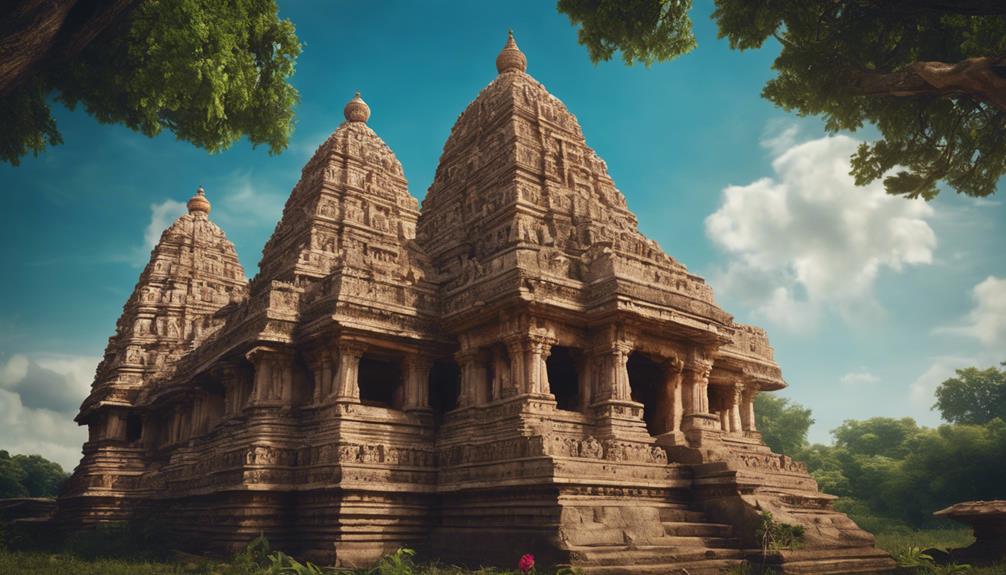
As you step into Sitamarhi's Ancient Sita Temple, you're transported to a world of myth and legend.
You'll soon discover the significance of this sacred site, where Sita, the goddess of purity and devotion, is said to have left her sacred footprints.
Get ready to explore the temple's rich history, symbolism, and spiritual significance as you venture deeper into this ancient wonder.
Overview
Located just 60 kilometers from Varanasi, the ancient Sita Temple in Sitamarhi is a sacred destination that beckons devotees and curious travelers alike, promising a journey through the domain of myth and history.
As you step into this revered site, you'll set out on Mata Sita's Journey, tracing the footsteps of Lord Rama's wife as she disappeared into the earth. This sacred pilgrimage is a once-in-a-lifetime experience, especially during Navratris of Chaitra and Ashwin months when hundreds of devotees flock to this temple.
The Sita Samahit Sthal, as it's also known, is a stunning temple complex that houses not only Sita's shrine but also idols of Lord Rama, Lakshmana, and Hanuman.
The intricate carvings, vibrant colors, and peaceful ambiance create an immersive experience, transporting you to a bygone era.
With its rich cultural heritage and spiritual significance, the Sitamarhi temple is an unmissable day-trip destination from Varanasi.
As you explore this ancient site, you'll uncover the secrets of Hindu mythology and immerse yourself in the sacred pilgrimage that has been a cornerstone of Indian culture for centuries.
Sita's Sacred Footprints
You stand before the revered Sita Temple, where legend has it that the earth swallowed Mata Sita, leaving behind a sacred footprint that has been immortalized in stone.
As you step inside, you're enveloped in an aura of serenity, and the weight of mythical legends settles upon you. The ancient temple, nestled in Sitamarhi, is a sacred pilgrimage site, drawing devotees from far and wide.
The air is thick with devotion, as you undertake a spiritual journey, tracing the footsteps of the divine.
As you wander through the temple's hallowed halls, you're struck by the intricate carvings and vibrant frescoes that adorn the walls.
The sacred footprint, said to be Mata Sita's, is the pièce de résistance, radiating an otherworldly energy. You can't help but feel a deep sense of reverence, as the mythical legends of the Ramayana come alive before your eyes.
The Sita Temple is more than just a relic of the past; it's a symbol of the enduring power of faith and devotion.
As you soak in the tranquil atmosphere, you're reminded that, in this sacred space, the boundaries between myth and reality blur, and the divine becomes palpable.
Bring Power Bank Backup
Before venturing into the sacred precincts of Sitamarhi's ancient Sita Temple, don't forget to pack a power bank to keep your devices charged, lest you're left in the dark, struggling to capture the divine essence of this revered site.
You never know when power outages might strike, leaving you without a way to document your experience. As a traveler, being prepared with the right travel essentials is vital.
A portable power bank is a must-have to keep your devices powered throughout your journey.
As you wander through the temple's ancient corridors, you'll want to capture every moment, from the intricate carvings to the serene atmosphere.
A dead phone or camera battery can be a major buzzkill. By bringing a power bank, you'll have peace of mind, knowing you can snap away without worrying about running out of juice.
This small but vital item will guarantee you can focus on soaking up the spiritual energy of the temple, rather than stressing about your device's battery life.
Shahi Quila's Royal Architecture
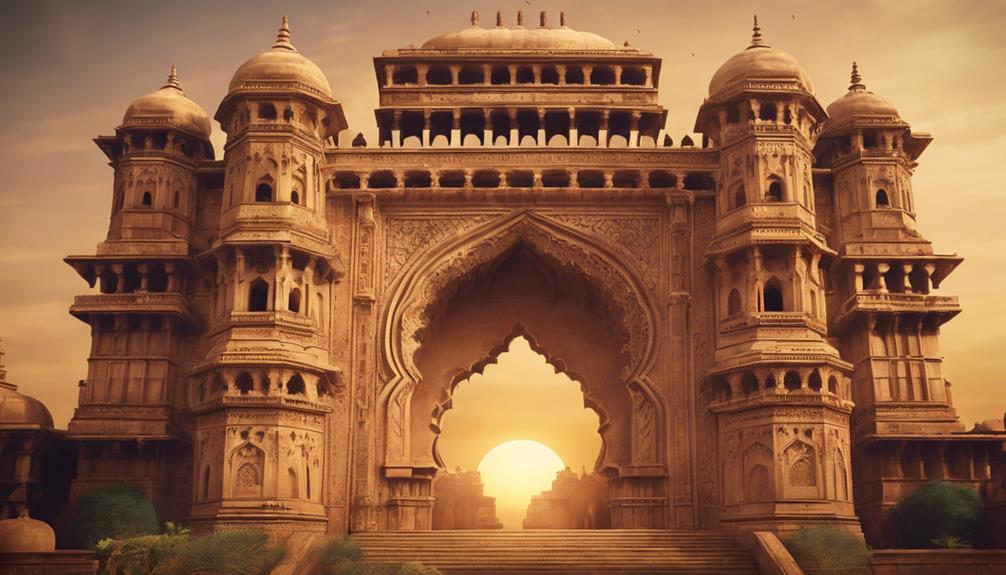
As you explore Shahi Quila's Royal Architecture, you'll be struck by the fort's majestic blend of Mughal and Rajput styles, characterized by intricate carvings, ornate decorations, and majestic gates.
You'll notice the influence of iconic Mughal emperors like Akbar, Shah Jahan, and Aurangzeb in the fort's design, featuring a mix of arches, domes, and minarets.
As you walk through the complex, take in the exceptional craftsmanship on display in the temple, mosque, and palaces, including the Khas Mahal and Rang Mahal.
Overview
Shahi Quila's majestic façade, adorned with intricate carvings and ornate balconies, stands as a monument to the grandeur of Mughal architecture.
As you approach this stunning fort, you can't help but feel the weight of history beneath your feet.
Located just a short drive from Varanasi, Shahi Quila is an oasis of cultural significance, waiting to be explored.
You'll be fascinated by the rich Varanasi history that permeates every brick and mortar of this ancient fort.
The fort's royal architecture is a reflection of the region's rich cultural heritage, showcasing the perfect blend of Mughal and Indian styles.
As you wander through the fort's majestic halls and chambers, you'll uncover the stories of the region's glorious past.
With its stunning architecture, fascinating history, and cultural significance, Shahi Quila is a must-visit destination for anyone interested in exploring the rich heritage of Varanasi.
Majestic Shahi Quila Architecture
Stepping into the majestic Shahi Quila, you're immediately struck by the grandiose architecture that seamlessly blends Indian, Islamic, and European styles, reflecting the region's rich cultural legacy.
As you explore the fort, you'll notice the intricate carvings, ornate decorations, and majestic halls that showcase the craftsmanship of the artisans who built it in the 17th century.
The Shahi Quila's palace design is a marvel, with ornate balconies, carved marble, and ornamental stucco work that will leave you in awe.
The fort's architecture is a reflection of the region's rich cultural heritage, with its unique blend of styles that reflect the region's Fort History.
From the intricate carvings to the ornate decorations, every aspect of the Shahi Quila's design is a reflection of the region's rich cultural legacy.
As you wander through the complex, you'll get a glimpse into the region's past, with the museum showcasing a vast collection of artifacts, including antique furniture, costumes, and other relics.
The Shahi Quila's majestic architecture is a must-visit destination for anyone interested in Fort History and Palace Design.
Wear Comfortable Walking Sandals
With the grandeur of Shahi Quila's royal architecture unfolding before your eyes, make sure you're wearing comfortable walking sandals to fully appreciate the intricate carvings, ornate decorations, and majestic halls that await you.
The sand-friendly terrain of the fort's courtyards and corridors is perfect for exploring, but only if your feet are comfortable.
You'll want to take your time to absorb the history and beauty of this 16th-century fort, and that's hard to do if you're wincing in pain with every step.
So, don't forget to prioritize sole care tips like wearing breathable sandals, applying sunscreen to your feet, and taking regular breaks to rest your feet.
With comfortable sandals, you'll be free to focus on the stunning views of the Ganges River, the ornate gates, and the imposing walls that reflect the grandeur of the Mughal Empire.
Mirzapur's Ancient Rock Carvings
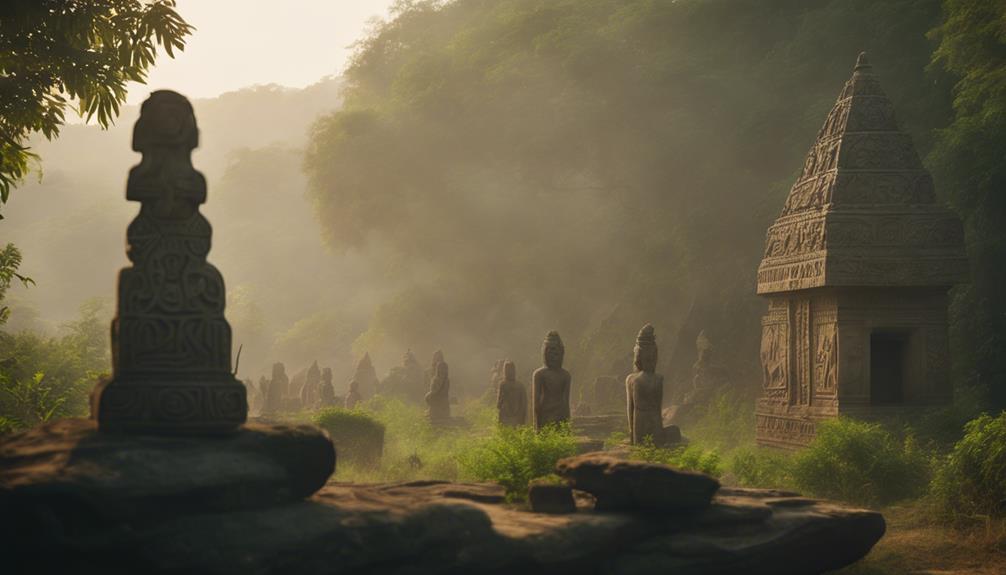
As you make your way to Mirzapur, you're about to uncover the secrets of India's ancient past, where the rocky outcrops near the Vindhya Mountains hold a treasure trove of ancient rock carvings.
You'll get to marvel at the intricate designs and motifs that have been preserved for thousands of years, and discover the fascinating techniques used to create these prehistoric masterpieces.
With an overview of the site, a closer look at the ancient rock carvings display, and some practical tips to avoid slippery paths, you're all set for an unforgettable adventure.
Overview
Nestled in the rugged terrain of the Vindhya Hills, the ancient rock carvings of Mirzapur await your discovery, offering a fascinating glimpse into the region's rich cultural legacy.
As you venture on a regional exploration of this hidden gem, you'll uncover the cultural significance of these ancient carvings, which date back to the 5th century BCE. The intricate designs and ornate patterns that adorn the rocks are a reflection of the skill and craftsmanship of ancient Indian artists.
You'll find yourself immersed in a world of mythological scenes, with depictions of Lord Shiva, Goddess Durga, and other Hindu deities.
The rock carvings are a window into the region's geological and cultural history, providing a unique perspective on the Vindhya Hills and their significance in Indian heritage.
As you explore further into the history of these carvings, you'll appreciate the cultural significance of Mirzapur's ancient rock carvings, making this regional exploration an unforgettable experience.
Ancient Rock Carvings Display
You'll be mesmerized by the intricate designs and vivid scenes that unfold before your eyes as you explore the ancient rock carvings display in Mirzapur, where centuries-old stories of India's rich cultural heritage come alive.
Dating back to the Paleolithic era, these 10,000 to 20,000-year-old rock art masterpieces offer a glimpse into the lives of early humans.
The Vindhyan hills, composed of sandstone and limestone, serve as the canvas for these ancient works of art. As you wander through the rocky outcrops and vertical faces, you'll discover intricate depictions of animals, humans, and abstract shapes, showcasing the early artistic expressions of human civilization.
The carvings, some measuring up to 3 meters in length, are remarkably well-preserved, providing valuable insights into the cultural and artistic developments of ancient India.
This archaeological treasure trove is a legacy to the region's rich Rock Art heritage, offering a unique window into the lives of our ancient ancestors and their Early Civilization.
Avoid Slippery Paths
Before exploring Mirzapur's ancient rock carvings, make sure to wear sturdy shoes with good grip, as the paths leading to these natural wonders can be deceptively slippery.
You'll be grateful for the extra traction when trekking the trails, which can be uneven and rocky.
As you hike, keep an eye out for loose stones and roots that could send you tumbling.
Trail safety is key, so take your time and avoid rushing through the trails.
Remember, it's better to take small, careful steps than to risk a nasty fall.
As you make your way to the rock carvings, take in the stunning scenery around you.
The lush green forests and rolling hills provide a picturesque backdrop for your adventure.
But don't get too distracted – stay focused on the path ahead and watch for warning signs or caution tape.
It's also a good idea to bring plenty of water and snacks, as the trails can be physically demanding.
Devdari Waterfall's Serene Atmosphere
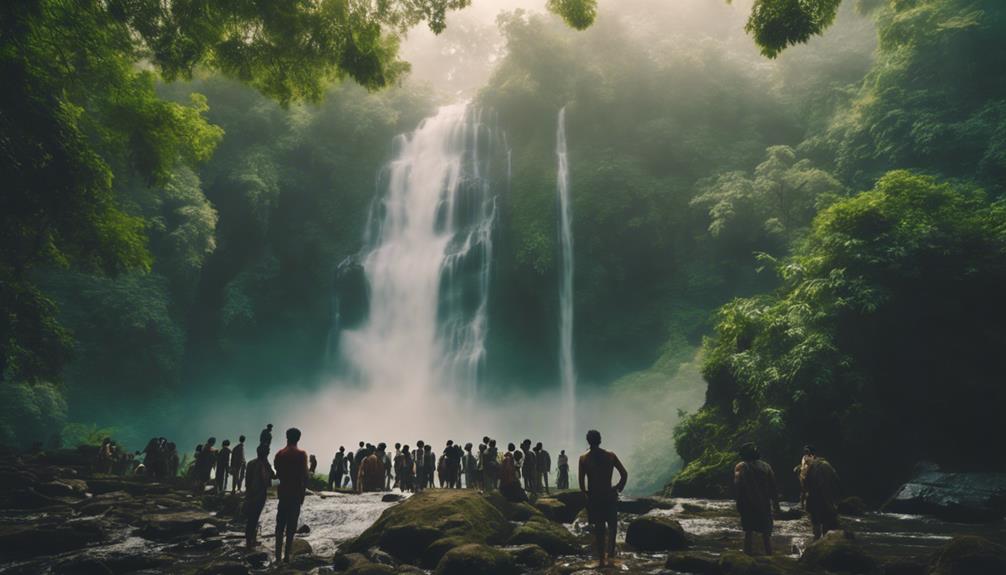
As you make your way to Devdari Waterfall, you'll be enveloped in a serene atmosphere that's perfect for a relaxing getaway.
You're about to discover the untouched beauty of this hidden gem, surrounded by lush green forests and teeming with natural charm.
Get ready to soak up the tranquil ambiance and breathtaking views that await you at this picturesque waterfall.
Overview
Nestled in the heart of the Kaimur Hills, Devdari Waterfall's serene atmosphere envelops you in a sense of tranquility, its gentle cascade of crystal-clear waters against the rugged landscape a soothing balm for the senses. As you step into this natural haven, you'll feel the weight of your worries slowly lifting, replaced by a deep sense of calm and connection with nature.
Devdari Waterfall holds significant cultural importance, with many locals believing it to be a sacred site. You'll notice devotees and pilgrims visiting the waterfall, seeking spiritual solace and enlightenment.
To reach this scenic spot, you can take local transportation from Varanasi, which includes buses and taxis. The journey takes around an hour, giving you ample time to soak in the scenic views of the Kaimur Hills.
Once you arrive, take a moment to breathe in the fresh air, listen to the gentle roar of the waterfall, and let the natural beauty of Devdari envelop you. With its serene atmosphere and cultural significance, Devdari Waterfall is an ideal getaway from the hustle and bustle of city life.
Sparkling Waterfall Cascade View
Standing at the edge of the waterfall, you're treated to a breathtaking spectacle: a mesmerizing cascade of crystal-clear water that tumbles down the rocky slope, creating a misty veil that rises into the air, imbuing the surroundings with an otherworldly aura.
As you take in the scenery, you can't help but feel a sense of tranquility wash over you. The roar of the waterfall creates a soothing melody that blocks out the din of the world, leaving you to bask in the serenity of this natural wonder.
The Devdari Waterfall is a showcase of the incredible beauty of India's natural landscapes. The scenic views surrounding the waterfall are simply stunning, with lush greenery and vibrant flora adding to the area's charm.
As you explore the area, you'll discover hidden gems, like the numerous natural pools and streams that crisscross the landscape. Take a moment to dip your toes in the cool, clear water or simply sit back and soak up the tranquil atmosphere.
This Natural Wonder is a must-visit for anyone seeking a respite from the hustle and bustle of city life, and its Scenic Landscapes will leave you in awe.
Wear Water-Friendly Shoes Always
Slip on your water-friendly shoes and step into the serene atmosphere of Devdari Waterfall, where a misstep on the rocky path could quickly turn a tranquil escape into a slippery slope.
As you make your way to the waterfall, the lush green forests and hills surrounding you'll transport you to a world of tranquility.
The 20-meter high waterfall creates a soothing atmosphere, perfect for relaxation and rejuvenation.
But don't let the serene surroundings fool you – the path to the waterfall can be treacherous, making water-friendly shoes a must-have.
With the right gear, you'll be free to explore the riverbed and indulge in some forest hiking, taking in the untouched beauty of the surroundings.
As an offbeat destination, Devdari Waterfall offers an unspoiled experience, far from the crowds and chaos of city life.
Tanda Falls' Natural Beauty
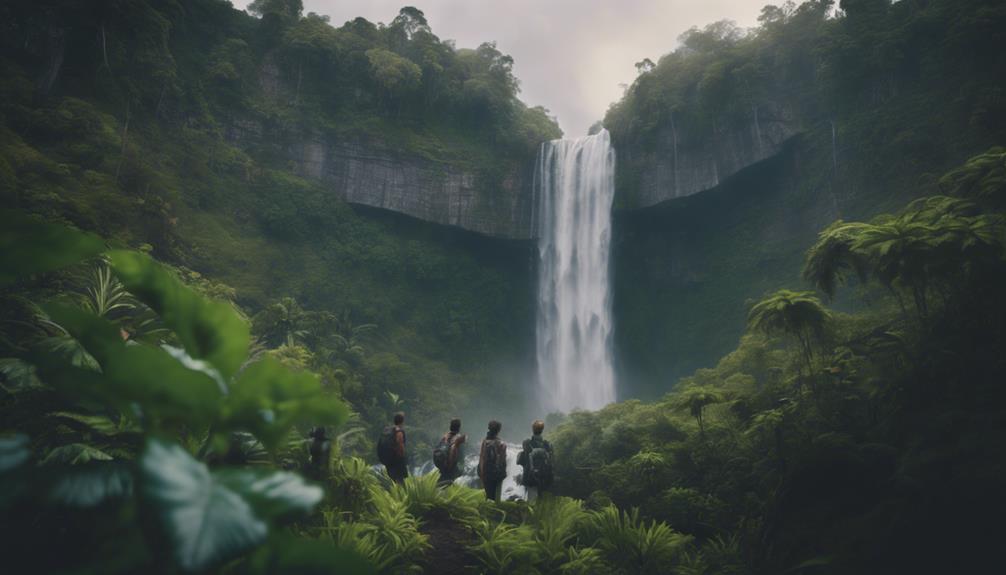
As you venture into the picturesque Tanda village, you'll discover the stunning Tanda Falls, a natural wonder that's sure to leave you awestruck.
Get ready to marvel at the towering waterfall, surrounded by lush green forests, and experience the thrill of capturing its breathtaking beauty.
With its easy accessibility from Varanasi and Mirzapur, you'll want to grab your waterproof phone case and get ready to soak up the natural splendor of Tanda Falls.
Overview
Tucked away in the heart of the Indian state of Uttar Pradesh, Tanda Falls presents a breathtaking spectacle of natural beauty, its crystal-clear waters cascading down rugged rock formations, surrounded by lush green forests that seem to hum with the sweet songs of exotic birds.
As you step into this serene oasis, you'll feel the tranquility of nature wash over you, a perfect respite from the hustle and bustle of city life.
Having explored the spiritual hub of Varanasi, with its rich Varanasi Heritage and Sacred Pilgrimage sites, you'll appreciate the contrast of this natural wonder.
You'll find yourself mesmerized by the falls' majestic beauty, an emblem of the region's untamed charm.
Take a deep breath, and let the freshness of the surroundings rejuvenate you.
As you wander through the forest, the gentle rustling of leaves and chirping of birds will be music to your ears.
Let Tanda Falls be your haven, a place to unwind and reconnect with nature.
Towering Tanda Falls Plunge
You stand at the edge of the falls, and the roar of Tanda Falls Plunge grows louder, its misty veil rising like an ethereal curtain, beckoning you to step into the heart of this natural wonder.
As you take your first step forward, the cool mist envelops you, revitalizing your senses and invigorating your spirit. The towering falls plunge into the depths below, creating a breathtaking spectacle that leaves you awestruck.
As you explore the surroundings, you'll notice the lush greenery and vibrant flora that thrive in the misty atmosphere.
The air is filled with the sweet songs of birds, adding to the serene ambiance.
For the adventurous, Tanda Falls Plunge offers exciting opportunities for Plunge Adventures, such as rappelling and rock climbing.
However, prioritizing Falls Safety is crucial, ensuring you take necessary precautions to minimize risks.
With proper guidance and equipment, you can indulge in these thrilling activities while soaking in the beauty of nature.
Bring Waterproof Phone Case
With the misty veil of Tanda Falls Plunge surrounding you, be sure to shield your phone from the unpredictable sprays of water and mist by bringing a waterproof phone case to capture the breathtaking beauty of this natural wonder.
As you immerse yourself in the lush green surroundings, you'll want to take stunning photos and videos to relive the experience.
A waterproof phone case will give you the freedom to get up close and personal with the falls, without worrying about damaging your device.
You can even take part in water sports like swimming or kayaking, knowing your phone is protected.
Don't let a damaged phone ruin your adventure! Invest in a reliable waterproof phone case, a must-have phone accessory for any nature enthusiast.
With this essential item, you'll be able to focus on the thrill of the experience, capturing every magical moment at Tanda Falls.
Lord Cornwallis Tomb

As you venture into the historic town of Ghazipur, you'll come face-to-face with the majestic Lord Cornwallis Tomb, a stunning example of Indo-Islamic architecture.
This beautiful tomb, surrounded by lush gardens, holds a rich history and significance in the annals of British colonial rule in India.
Get ready to uncover the fascinating story of Lord Cornwallis, a renowned British general and politician, as you explore this impressive monument.
Overview
Located in Ghazipur district, approximately 80 km east of Varanasi, Lord Cornwallis Tomb stands as a monument to the life and legacy of a British general and administrator who left an indelible mark on Indian history.
As you approach the tomb, you'll be struck by its serene surroundings – lush green gardens that provide a peaceful atmosphere, perfect for reflection.
The tomb itself is a beautiful example of British-era architecture, a symbol of the British History that has shaped India's past.
You'll learn about Lord Cornwallis's significant role in Indian Legacy, his administrative skills, and military campaigns that have left a lasting impact on the subcontinent.
As you explore the tomb, you'll discover exhibits and information that bring his life and achievements to life.
You'll gain a deeper understanding of the man behind the monument, and the significance of his legacy in Indian history.
Take a moment to appreciate the tranquil atmosphere, and let the history of the tomb wash over you.
Historic British Colonial Architecture
Lord Cornwallis Tomb's stunning architecture is a monument to the British colonial era's cultural fusion, where European grandeur meets Indian ornamentation.
As you step into the beautiful garden surrounding the tomb, you'll be struck by the serene atmosphere and the intricate carvings that adorn the structure.
Located approximately 80 km east of Varanasi in Ghazipur district, this historic monument is a must-visit destination for anyone interested in exploring India's colonial legacy.
The tomb, built in 1798, is a reflection of the architectural fusion of European and Indian styles, showcasing the cultural exchange that defined the British colonial era.
The ornate decorations and intricate carvings are a tribute to the skill of Indian craftsmen, who blended European grandeur with Indian ornamentation to create a unique style.
As you walk around the tomb, you'll notice the well-manicured lawns and lush greenery, making it a peaceful oasis in the midst of a bustling region.
The Archaeological Survey of India (ASI) has done an excellent job in maintaining the tomb, ensuring its preservation for future generations.
Respectful Grave Visiting Etiquette
When visiting the Lord Cornwallis Tomb, take a moment to reflect on the significance of this historic site and show respect for the final resting place of a prominent figure in Indian colonial history.
As you approach the tomb, remember to maintain Grave Decorum, being mindful of your tone and behavior. This is a place of reverence, not a tourist attraction.
Switch your phone to silent mode, and refrain from loud conversations or laughter. Dress modestly, avoiding revealing clothing that may be deemed disrespectful.
When taking photos, avoid posing or making gestures that may be perceived as disrespectful. Funeral Etiquette dictates that you show respect for the deceased and their loved ones.
Keep your voice down, and avoid touching or climbing on the tomb. Be respectful of the beautiful garden surroundings, and take nothing but memories and leave nothing but bubbles.
Frequently Asked Questions
Which Places Are Close to Varanasi?
You're looking for places close to Varanasi? Head to Sarnath, just 10 km away, for Buddhist pilgrimages and stunning stupas. Alternatively, explore the majestic Ramnagar Forts, a mere 15 km from the city center.
Which Places to Visit Under 300 Km From Varanasi?
Did you know that 70% of India's tigers inhabit the regions surrounding Varanasi? You'll find thrilling Wildlife Escapes within 300 km, like the Pilibhit Tiger Reserve. Explore Ancient Ruins like the majestic Bhimbetka Rock Shelters, a UNESCO World Heritage Site, just a few hours away!
Which Hill Station Is Near Varanasi?
You're looking for a hill station near Varanasi? Head to Mussoorie Hill, a scenic getaway with breathtaking views, or visit Bhimtal Lake, surrounded by lush greenery, for a relaxing retreat from the city's chaos.
Where to Travel From Varanasi?
"You're craving a break from Varanasi's spiritual chaos, and you're wondering where to travel from here. Why not escape to the mystical Himalayas for a rejuvenating Spiritual Escape or explore the uncharted Offbeat Getaway of Nepal's Terai region?"
Conclusion
As you venture out of Varanasi, you'll discover a treasure trove of hidden gems within a 100 km radius.
From ancient temples to majestic forts, and breathtaking waterfalls to serene atmospheres, each destination is a reflection of the region's rich history and natural beauty.
Did you know that the Chunar Fort, a blend of Indian, Persian, and Islamic architectural styles, has been in existence since the 16th century?
Explore these uncharted territories and uncover the secrets they hold.
